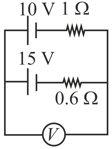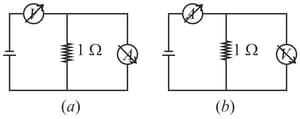Explain how a moving coil galvanometer is converted into voltmeter. Derive the necessary formula.
Important Questions on Moving Charges and Magnetism


Derive the expression for the torque acting on the rectangular current carrying coil of a galvanometer. Why is the magnetic field made radial?
A student uses the resistance of a known resistor ( ) to calibrate a voltmeter and an ammeter using the circuits shown below. The student measures the ratio of the voltage to current to be in circuit
(a) and in circuit (b). From these measurements, the resistance (in ) of the voltmeter and ammeter are found to be close to

How do you convert a moving coil galvanometer into an ammeter?
Higher the range, greater is the resistance of ammeter.
To increase the range of ammeter, additional shunt needs to be used across it.
A galvanometer has a 50 division scale. Battery has no internal resistance. It is found that there is deflection of 40 divisions when Deflection becomes 20 divisions when resistance taken from resistance box is 4900 Ω. Then we can conclude :

Note: This question is awarded as the bonus. Now the question is corrected.
Distinguish between ammeter and voltmeter.

